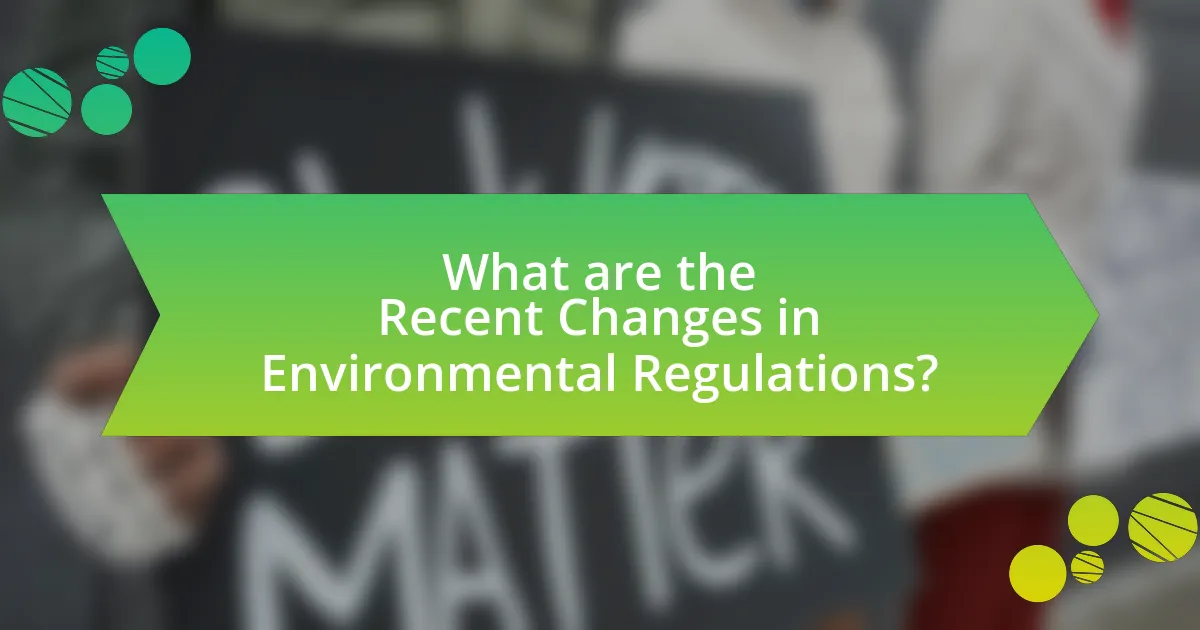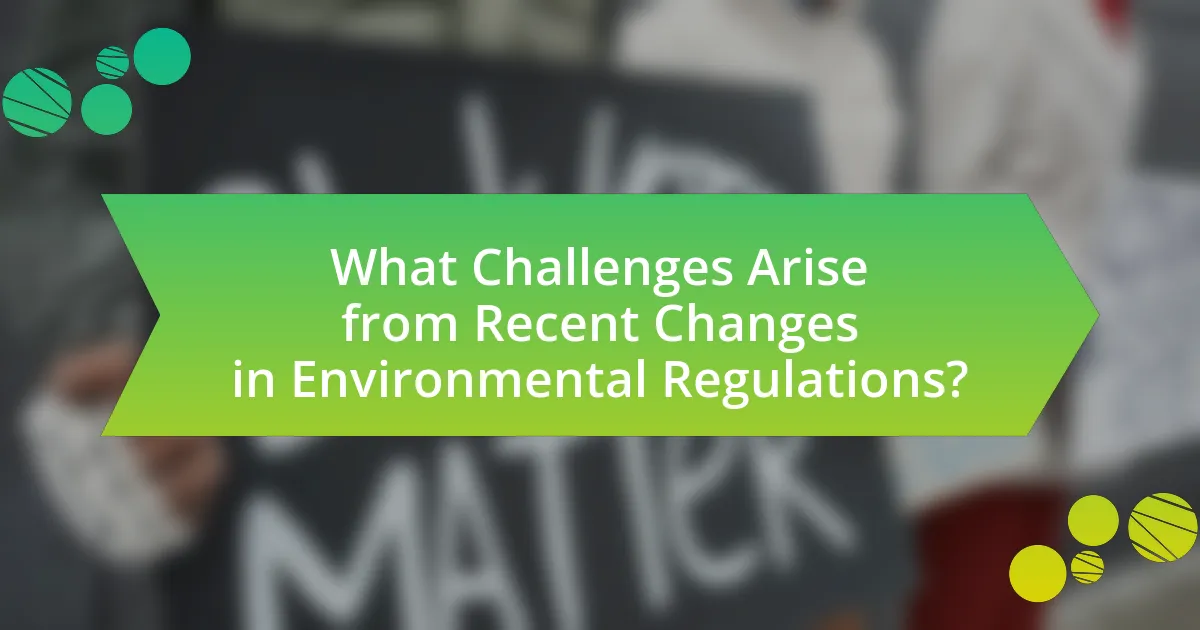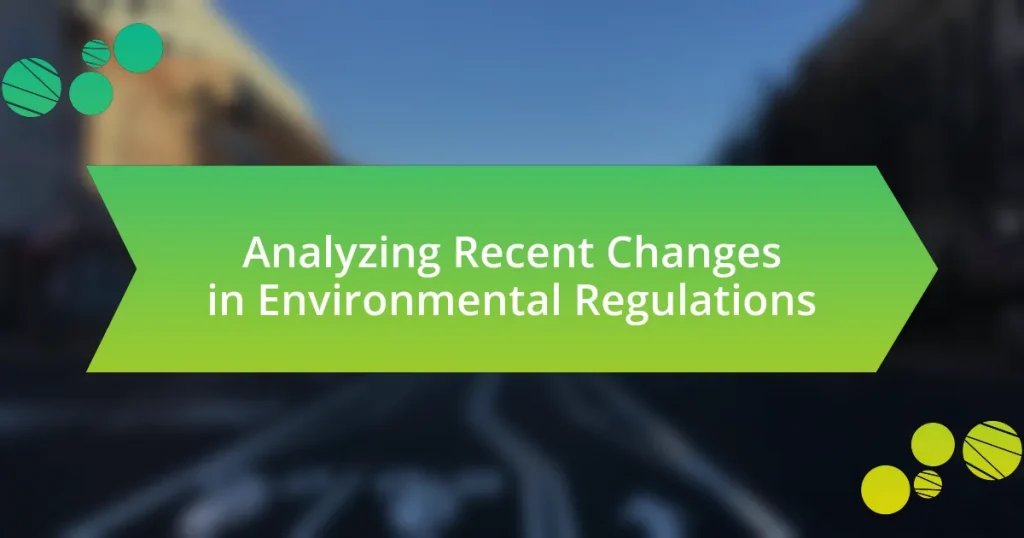The article analyzes recent changes in environmental regulations, highlighting the implementation of stricter emissions standards aimed at reducing air pollution and greenhouse gas emissions. It discusses the influence of global events, such as climate change agreements and environmental disasters, on these regulatory shifts. Key areas affected include air quality, water resources, and biodiversity conservation, with significant impacts on industries like energy, manufacturing, and transportation. The article also addresses the implications for public health, the importance of compliance, and the challenges businesses face in adapting to new regulations, including increased costs and the need for technological upgrades.

What are the Recent Changes in Environmental Regulations?
Recent changes in environmental regulations include the implementation of stricter emissions standards for vehicles and industrial facilities, aimed at reducing air pollution and greenhouse gas emissions. For instance, the U.S. Environmental Protection Agency (EPA) has introduced new rules that require a significant reduction in nitrogen oxides and particulate matter from power plants, which is expected to decrease health risks associated with air quality. Additionally, the European Union has updated its Climate Law to ensure that member states collectively reduce greenhouse gas emissions by at least 55% by 2030 compared to 1990 levels, reinforcing commitments made in the Paris Agreement. These regulatory shifts reflect a global trend towards more stringent environmental protections and climate action.
How have these changes been influenced by global events?
Recent changes in environmental regulations have been significantly influenced by global events such as climate change agreements, international summits, and environmental disasters. For instance, the Paris Agreement of 2015 prompted countries to enhance their commitments to reduce greenhouse gas emissions, leading to stricter national regulations. Additionally, events like the 2010 Deepwater Horizon oil spill raised public awareness and urgency regarding environmental protection, resulting in more stringent regulations in the oil and gas industry. These global events have catalyzed a shift towards more comprehensive and enforceable environmental policies worldwide.
What role does climate change play in shaping these regulations?
Climate change significantly influences the development of environmental regulations by necessitating stronger measures to mitigate its impacts. As global temperatures rise and extreme weather events become more frequent, governments are compelled to implement regulations aimed at reducing greenhouse gas emissions and promoting sustainable practices. For instance, the Paris Agreement, adopted in 2015, established legally binding commitments for countries to limit global warming, thereby shaping national policies and regulations focused on emissions reduction. Additionally, scientific reports, such as those from the Intergovernmental Panel on Climate Change, provide evidence of climate change’s effects, prompting regulatory bodies to adapt and strengthen environmental laws to address these urgent challenges.
How do international agreements impact national regulations?
International agreements significantly influence national regulations by establishing binding commitments that countries must adhere to, often leading to the harmonization of laws and standards. For instance, the Paris Agreement on climate change compels signatory nations to implement policies aimed at reducing greenhouse gas emissions, thereby prompting countries to revise their environmental regulations to meet international targets. This alignment can be seen in the European Union’s directives, which require member states to adopt specific environmental protections, demonstrating how international frameworks directly shape domestic legal frameworks.
What are the key areas affected by these regulatory changes?
The key areas affected by recent regulatory changes in environmental regulations include air quality, water resources, waste management, and biodiversity conservation. These changes often aim to reduce emissions, improve water quality standards, enhance waste disposal practices, and protect endangered species. For instance, the Clean Air Act amendments have led to stricter limits on pollutants, resulting in improved air quality in urban areas. Additionally, the Clean Water Act has introduced more rigorous standards for industrial discharges, significantly impacting water resource management. These regulatory shifts are designed to address environmental challenges and promote sustainability.
Which industries are most impacted by new environmental laws?
The industries most impacted by new environmental laws include energy, manufacturing, agriculture, and transportation. These sectors face stringent regulations aimed at reducing emissions, managing waste, and promoting sustainable practices. For instance, the energy industry is significantly affected by laws targeting carbon emissions, with many countries implementing stricter limits on fossil fuel usage. The manufacturing sector must comply with regulations regarding hazardous materials and waste disposal, which can lead to increased operational costs. Agriculture is impacted by laws related to pesticide use and water management, while the transportation industry is subject to emissions standards that require investment in cleaner technologies. These regulations are designed to mitigate environmental damage and promote sustainability, thereby reshaping operational practices across these industries.
How do these changes affect public health and safety?
Recent changes in environmental regulations significantly enhance public health and safety by reducing exposure to harmful pollutants. For instance, stricter emissions standards for industries lead to lower levels of air and water contaminants, which directly correlates with decreased respiratory diseases and improved overall community health. According to the Environmental Protection Agency, implementing the Clean Air Act has resulted in a 70% reduction in six common air pollutants since 1970, contributing to an estimated 230,000 fewer premature deaths annually. These regulatory changes not only protect vulnerable populations, such as children and the elderly, but also promote safer environments, thereby fostering healthier communities.

Why are Environmental Regulations Important?
Environmental regulations are important because they protect public health and the environment from harmful pollutants and practices. These regulations establish standards that limit emissions of toxic substances, ensuring cleaner air and water, which directly contributes to improved health outcomes. For instance, the Clean Air Act has led to a significant reduction in air pollutants, resulting in an estimated 230,000 fewer premature deaths in 2020 alone, according to the Environmental Protection Agency. By enforcing compliance, environmental regulations also promote sustainable practices that preserve natural resources for future generations.
What are the primary goals of environmental regulations?
The primary goals of environmental regulations are to protect human health, preserve natural resources, and ensure sustainable development. These regulations aim to limit pollution, manage waste, and conserve biodiversity, thereby mitigating the adverse effects of industrial activities on the environment. For instance, the Clean Air Act in the United States sets standards for air quality to safeguard public health and the environment, demonstrating the effectiveness of regulatory frameworks in achieving these goals.
How do these regulations protect natural resources?
Environmental regulations protect natural resources by establishing legal frameworks that limit pollution, conserve ecosystems, and promote sustainable resource management. These regulations, such as the Clean Water Act and the Endangered Species Act, set standards for air and water quality, restrict harmful emissions, and protect habitats critical for biodiversity. For instance, the Clean Water Act has led to significant reductions in water pollution, improving the health of aquatic ecosystems and ensuring safe drinking water for communities. Additionally, regulations often require environmental impact assessments, which help identify potential harm to natural resources before projects are approved, thereby safeguarding ecosystems from degradation.
What is the significance of biodiversity in regulatory frameworks?
Biodiversity is significant in regulatory frameworks because it underpins ecosystem health and resilience, which are critical for sustainable development and environmental protection. Regulatory frameworks that incorporate biodiversity considerations help ensure the conservation of species and habitats, thereby maintaining ecological balance. For instance, the Convention on Biological Diversity, established in 1992, emphasizes the importance of biodiversity in achieving sustainable development goals and informs national policies aimed at protecting ecosystems. Additionally, regulations that promote biodiversity can enhance ecosystem services, such as pollination and water purification, which are vital for human well-being and economic stability.
How do regulations promote sustainable practices?
Regulations promote sustainable practices by establishing legal frameworks that require businesses and individuals to adhere to environmentally friendly standards. These regulations often include limits on emissions, mandates for waste reduction, and incentives for using renewable resources, which collectively drive innovation and accountability in sustainability efforts. For example, the Clean Air Act in the United States has significantly reduced air pollution by enforcing emission standards, leading to improved public health and environmental quality. Additionally, regulations such as the European Union’s REACH (Registration, Evaluation, Authorisation, and Restriction of Chemicals) ensure that chemicals used in products are assessed for their environmental impact, thereby promoting safer alternatives and sustainable practices across industries.
What incentives do regulations provide for businesses to adopt green technologies?
Regulations provide financial incentives, such as tax credits and grants, to encourage businesses to adopt green technologies. These incentives reduce the initial investment costs associated with implementing sustainable practices, making it more financially viable for companies to transition to environmentally friendly technologies. For example, the U.S. federal government offers the Investment Tax Credit (ITC) for solar energy systems, allowing businesses to deduct a significant percentage of the installation costs from their federal taxes. Additionally, many states provide rebates and low-interest loans for energy-efficient upgrades, further lowering the financial barriers for businesses. These regulatory incentives not only promote the adoption of green technologies but also contribute to long-term cost savings and compliance with environmental standards.
How do regulations encourage community involvement in environmental protection?
Regulations encourage community involvement in environmental protection by establishing frameworks that mandate public participation in decision-making processes. For instance, the National Environmental Policy Act (NEPA) requires federal agencies to involve the public in environmental assessments, thereby fostering community engagement. This involvement is further supported by regulations that promote transparency and accountability, such as the Clean Air Act, which mandates public hearings for proposed air quality standards. These legal requirements not only empower communities to voice their concerns but also ensure that local knowledge and priorities are integrated into environmental policies, ultimately leading to more effective and locally relevant environmental protection efforts.

What Challenges Arise from Recent Changes in Environmental Regulations?
Recent changes in environmental regulations pose challenges such as increased compliance costs, operational disruptions, and the need for technological upgrades. Businesses often face financial burdens due to the necessity of adapting to new standards, which can lead to higher prices for consumers. For instance, a report from the Environmental Protection Agency indicates that compliance with stricter emissions standards can increase operational costs by up to 20% for certain industries. Additionally, companies may experience disruptions in their supply chains as they adjust to new regulations, impacting productivity and profitability. Furthermore, the requirement for advanced technologies to meet these regulations can strain resources, particularly for small and medium-sized enterprises that may lack the capital for such investments.
What are the potential economic impacts of stricter regulations?
Stricter regulations can lead to increased operational costs for businesses, which may result in higher prices for consumers. For instance, a study by the National Bureau of Economic Research found that environmental regulations can raise compliance costs by an average of 3% to 5% for affected industries. Additionally, while stricter regulations can drive innovation and create new markets for green technologies, they may also lead to job losses in sectors unable to adapt quickly. The overall economic impact is thus a balance between increased costs and potential long-term benefits from sustainable practices.
How might businesses adapt to comply with new regulations?
Businesses might adapt to comply with new regulations by implementing comprehensive compliance programs that include training, audits, and updated operational procedures. For instance, companies may establish dedicated compliance teams to monitor regulatory changes and ensure adherence to environmental standards, such as the Clean Air Act or the Clean Water Act. Additionally, businesses can invest in technology to track emissions and waste management, thereby facilitating real-time compliance reporting. According to a study by the Environmental Protection Agency, organizations that proactively adapt to regulations can reduce their operational risks and enhance their sustainability practices, ultimately leading to improved public perception and financial performance.
What are the risks of non-compliance for companies?
The risks of non-compliance for companies include significant financial penalties, legal repercussions, and reputational damage. Companies that fail to adhere to environmental regulations may face fines that can reach millions of dollars, as evidenced by the Environmental Protection Agency’s enforcement actions, which imposed over $4 billion in penalties in 2020 alone. Additionally, non-compliance can lead to lawsuits and increased scrutiny from regulatory bodies, resulting in operational disruptions. Furthermore, a tarnished reputation can lead to loss of customer trust and decreased market share, as consumers increasingly favor environmentally responsible businesses.
How do these changes affect enforcement and compliance mechanisms?
Recent changes in environmental regulations enhance enforcement and compliance mechanisms by introducing stricter penalties and more rigorous monitoring requirements. These modifications compel organizations to adopt more robust compliance strategies, as non-compliance now incurs higher financial risks and legal repercussions. For instance, the implementation of real-time monitoring technologies allows regulatory bodies to detect violations more swiftly, thereby increasing the likelihood of enforcement actions. Additionally, the establishment of clearer guidelines and standards simplifies compliance for businesses, making it easier to adhere to regulations and reducing the ambiguity that often leads to violations.
What new technologies are being used for monitoring compliance?
New technologies being used for monitoring compliance include artificial intelligence (AI), blockchain, and Internet of Things (IoT) devices. AI enhances data analysis capabilities, allowing for real-time monitoring and predictive analytics to ensure adherence to regulations. Blockchain provides a secure and transparent way to track compliance data, ensuring integrity and traceability. IoT devices facilitate continuous monitoring of environmental parameters, enabling immediate detection of non-compliance. These technologies collectively improve the efficiency and accuracy of compliance monitoring in environmental regulations.
How are penalties for violations changing under new regulations?
Penalties for violations under new environmental regulations are increasing significantly. The revised regulations introduce higher fines and stricter enforcement measures aimed at deterring non-compliance. For instance, the Environmental Protection Agency (EPA) has raised the maximum civil penalty for violations from $37,500 to $50,000 per day, reflecting a commitment to enhance accountability. Additionally, the new regulations emphasize the importance of compliance through increased monitoring and reporting requirements, which further supports the enforcement of these heightened penalties.
What Best Practices Should Stakeholders Follow in Response to Regulatory Changes?
Stakeholders should conduct a comprehensive impact assessment to understand how regulatory changes affect their operations and compliance requirements. This involves analyzing the specific regulations, identifying affected areas, and evaluating potential risks and opportunities. For instance, a study by the Environmental Protection Agency indicates that proactive compliance strategies can reduce penalties by up to 30%. Additionally, stakeholders should engage in continuous monitoring of regulatory updates and participate in industry forums to stay informed about best practices and collaborative approaches. This engagement fosters a proactive culture that can lead to improved compliance and sustainability outcomes.
How can businesses effectively prepare for upcoming regulatory shifts?
Businesses can effectively prepare for upcoming regulatory shifts by conducting thorough assessments of current compliance frameworks and identifying potential gaps. This proactive approach allows organizations to align their operations with anticipated regulatory changes, such as those related to environmental standards. For instance, a study by the World Economic Forum highlights that companies that engage in regular compliance audits are 30% more likely to adapt successfully to new regulations. Additionally, investing in training programs for employees on regulatory updates ensures that the workforce is informed and capable of implementing necessary changes. By leveraging technology, such as compliance management software, businesses can streamline their processes and maintain real-time awareness of regulatory developments, further enhancing their preparedness.
What resources are available for understanding and complying with new regulations?
Resources available for understanding and complying with new regulations include government websites, industry associations, and legal advisory services. Government websites, such as the Environmental Protection Agency (EPA) and state regulatory agencies, provide official guidelines, updates, and compliance tools. Industry associations, like the National Association of Manufacturers, offer resources tailored to specific sectors, including best practices and compliance checklists. Legal advisory services, including law firms specializing in environmental law, provide expert guidance on navigating complex regulations. These resources are essential for ensuring compliance and staying informed about regulatory changes.





